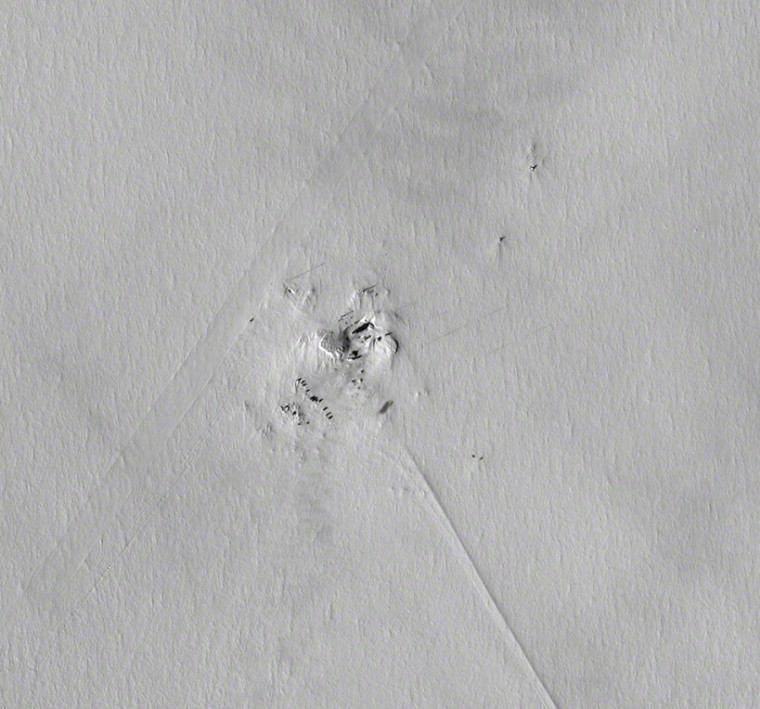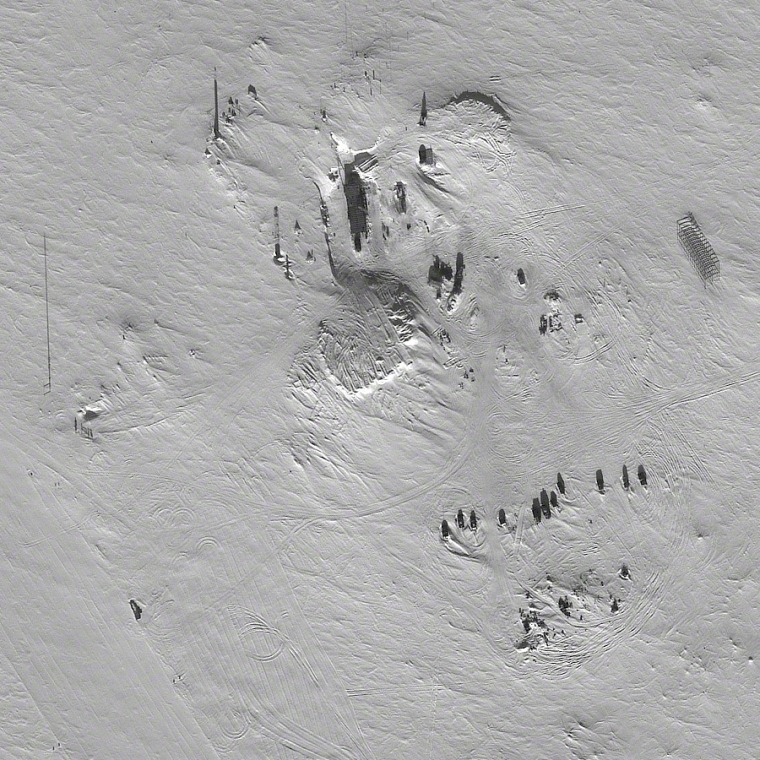The Russians say that drilling down to a 20 million-year-old lake in Antarctica, more than two miles beneath the surface, is the equivalent of putting an astronaut on the moon. If that's the case, this satellite photo from DigitalGlobe is the equivalent of watching Neil Armstrong and Buzz Aldrin at work.
The photo of Russia's Vostok Station was taken on Wednesday, just a couple of days after Russian researchers reached Lake Vostok in a delicate drilling operation that's been in the works since 1989. Scientists believe the gigantic subglacial reservoir may contain microbes or other organisms unlike any we've seen so far. The achievement also sets the stage for even more ambitious drilling projects that could take place someday on Europa, an ice-covered moon of Jupiter; or on Enceladus, a frozen Saturnian moon that spews forth geysers of water ice. Both those moons are thought to harbor huge subsurface oceans — and perhaps life as well.
The technological challenges involved in the drilling project, as well as the long-term implications raised by studying Lake Vostok, led the head of Russia's Arctic and Antarctic Research Institute, Valery Lukin, to say that "it's fair to compare this project to flying to the moon."
When the folks at DigitalGlobe's analysis group heard the news from Vostok Station, they checked into whether one of their three satellite eyes in the sky got a good look at the operation. They weren't disappointed. WorldView 1, orbiting more than 300 miles above the planet, got a clear shot showing the drilling tower and other structures at the facility.
"This goes to our ability to see anywhere on Earth on a daily basis," Chuck Herring, a director in DigitalGlobe’s analysis center, told me today.
The sun is illuminating the scene from the bottom of the picture, which means Vostok's structures and vehicles cast shadows that stretch up toward the top of the frame. The biggest shadow is cast by the station's main residence and office building, just above center. The drilling tower casts a long, thin shadow with a flag on top, above and to the left of the main building.
The shadows arrayed below and to the right of center are probably the vehicles used for overland transport to the Antarctic coast, said Peter Doran, an expert on polar lakes at the University of Illinois at Chicago. "They have these amazing, large vehicles with tracks," Doran told me. "They remind me of something out of 'Mad Max.'"
The square-sided area near the very center of the picture is apparently a built-up berm, most likely part of a storage facility for supplies or ice cores.

Paul Morin, director of the Polar Geospatial Center at the University of Minnesota, said one of the most remarkable things about the picture is ... how unremarkable it looks. "Stations like this look very much the same," he said. "Vostok is one of the most remote places on Earth. These guys have done an amazing feat, drilling at this location."
Doran said it was reassuring to see that everything looked normal, considering all the worries that researchers had about the Vostok drilling operation. Some observers feared that once the drill reached the lake, there'd be an explosive upwelling of water from the reservoir. To get international approval for the operation, the Russians had to conduct a detailed engineering analysis demonstrating that they were proceeding safely and surely.
"Even with all the numbers, you just had to wonder whether they had it right," Doran said. Based on the DigitalGlobe imagery,"it's clear that nothing really unusual happened," he said.
Morin said the imagery from DigitalGlobe and other providers has made a huge difference for scientists studying Antarctica's forbidding frontier. "Before commercial imagery, we had better pictures of Mars than we had of Antarctica," he observed. Aerial imagery of Vostok Station will be particularly helpful for scientists on the outside. "We have to stay abreast of what all these stations look like, because occasionally we have to go there," Morin said.
DigitalGlobe's Herring said his company is building up "a tremendous amount of imagery" every day — five times as much as any other commercial satellite image provider. "Right now our raw imagery archive grows by two petabytes of data per year," he said. That's 2 quadrillion bytes of data, which is a big or a small number, depending on your perspective. It's more image data than all the pictures that are stored on Facebook, but just a tenth the amount of data processed by Google on a daily basis.
No matter how you see it, keeping track of 2 quadrillion bytes' worth of images is a challenging task, but Herring said DigitalGlobe is up to the challenge. "Combining our constellation with the analysis center, we've seen a huge value, a tremendous amount of value for our customers," he said.
WorldView 1 and DigitalGlobe's other satellites will continue to keep watch on Vostok, "to monitor change and understand the facility, and validate what's said in the press about what's going on there," Herring said. For now, the Russians have closed up shop at the drilling site and hunkered down for the Antarctic winter. The researchers will return to their field work in a few months.
In the meantime, the Russians will have to lay out their plans to extract water samples from the lake itself. "If they're going to do that, they've got to write a new document that would be approved by an international body," Doran said. "They're not done. This was just the first pinprick."
Where in the Cosmos? Today's satellite picture of Vostok Station served as this week's "Where in the Cosmos" picture puzzle on the Cosmic Log Facebook page. Every week, we're serving up a mystery picture and asking Facebook fans to tell us what the picture shows. It took only four minutes for Martin Lynge of Nuuk, Greenland, to register the right answer — and as a reward, we're sending Martin a pair of 3-D glasses (courtesy of Microsoft Research) plus a 3-D picture of yours truly that will serve to scare the neighbors in Nuuk. To get in on next week's "Where in the Cosmos" contest, be sure to check out the Facebook page and hit the "like" button.
More fun with space pictures:
- Feb. 3: Moon craters and Mars colors
- Jan. 27: 3-D color map of the universe
- Jan. 20: Stephen Hawking's curios explained
Alan Boyle is msnbc.com's science editor. Connect with the Cosmic Log community by "liking" the log's Facebook page, following @b0yle on Twitter or adding Cosmic Log's Google+ page to your circle. You can also check out "The Case for Pluto," my book about the controversial dwarf planet and the search for other worlds.
